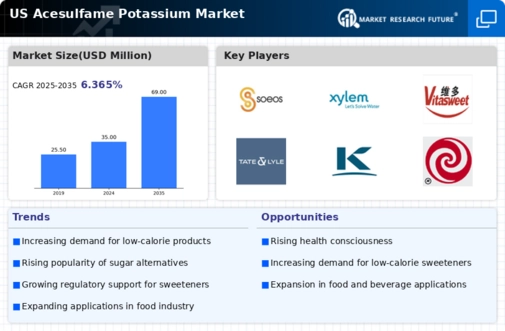The competitive insights of the US Acesulfame Potassium Market illustrate a dynamic and evolving landscape characterized by varied market participants striving for dominance in this sweetener segment. Acesulfame Potassium, often referred to as Acesulfame K, is gaining traction due to its growing utilization in low-calorie and sugar-free products. The market is driven by rising consumer awareness regarding health and wellness, with an increasing inclination toward sugar substitutes that provide desired sweetness without the associated calories. Players within this market are focusing on product innovation, strategic collaborations, and expansions to enhance their market footprint and refine their offerings.
This competitive environment is enabling stakeholders to adapt to changing consumer preferences and regulatory landscapes, promoting robust growth prospects in the sector.Soeos has established a notable presence within the US Acesulfame Potassium Market, leveraging its advanced manufacturing capabilities and commitment to quality. The company emphasizes producing high-purity Acesulfame Potassium, which meets various consumer and food industry standards. Soeos benefits from a strong distribution network that allows it to effectively reach a wide range of customers, including food and beverage manufacturers seeking clean-label, low-calorie solutions.
The company's focus on research and development enables it to implement innovative production techniques and develop new applications for Acesulfame Potassium, thus enhancing its competitive edge in the market. Moreover, Soeos prides itself on maintaining solid relationships with suppliers and distributors, which contribute to its resilient operational structure and marketplace reliability.Sensus operates effectively within the US Acesulfame Potassium Market, offering a diverse range of sweetener products, including Acesulfame Potassium, tailored to meet the needs of food manufacturers. The company is recognized for its commitment to quality assurance and adherence to food safety regulations.
Sensus is engaged in strategic mergers and acquisitions to bolster its market position, expand its product lineup, and access new consumer segments. With a strong emphasis on customer-centric solutions, Sensus caters to the growing demand for natural and alternative sweeteners in the US market. Its strength lies in a robust supply chain and an extensive array of partnerships with key players across the food and beverage industry, allowing the company to maximize its market reach and influence.
The continued focus on innovation and sustainability further solidifies Sensus's position as a prominent player in the acesulfame potassium market in the United States.























